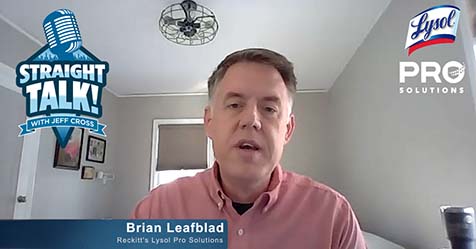You have probably heard of greenwashing—the practice of making misleading claims about the environmental benefits of a product. Similarly, Indoor Air Quality (IAQ)-washing involves making deceptive claims about how products will improve IAQ in a facility.
Avoiding HEPA hype with vacuums
As an example of IAQ-washing, some commercial vacuum cleaners are now labelled as “HEPA,” but a HEPA filter media attached to a vacuum’s exhaust is not the same as achieving HEPA-level filtration.
HEPA filters are only as effective as the amount of air passing through them at a volume and speed that enables removing particles at the 99.97% of .3 microns dust capture rate. Unfortunately, some HEPA-equipped units do not achieve HEPA-level performance or proper cleaning due to the media being undersized for the application or because it has become clogged due to a poor pre-filter system. Dust may also be escaping from other areas such as the vacuum-body seals or at the interface between the floor and vacuum.
The Carpet and Rug Institute (CRI) provides useful guidelines for buying vacuums based on soil removal, indoor air quality, and carpet wear or “appearance retention.” Many of the vacuums receiving CRI’s Seal of Approval are non-HEPA models. Why is this important?
CRI does chamber testing of vacuum cleaners, during which it measures the air in a chamber or closed room to detect dust emissions from all parts of a running vacuum rather than just the exhaust. Results of this testing have found that it is the overall system that makes a vacuum effective, not just having a HEPA filter attached to the exhaust stream.
Monitoring air for particles and gases
Airborne particles include dust, pollen, mold, smoke, bacteria and viruses, while gases include carbon dioxide, carbon monoxide, radon, formaldehyde, and volatile organic compounds (VOCs). Both particles and gases can have harmful impacts on a person’s respiratory, nervous, immune, and cardiovascular systems, depending on the type, size, distribution, and exposure level of pollutants, as well as the vulnerability of your facility’s occupants.
You can’t easily turn a facility into a controlled test chamber for particle and or gaseous emissions, but you can do the next best thing—install an active air quality monitor.
An active air quality monitor can measure IAQ over time and in real time from different sources. It can measure IAQ continuously through different tasks and scenarios (cleaning, walking across floors or carpets, with the HVAC operating and with the HVAC not operating, etc.) in a single space such as an office, hospital room, or classroom.
While a handheld particle counter can pinpoint a source of particles such as a vacuum’s or air purifier’s exhaust, it is often better to monitor room air quality over time and in real time as this best represents the health and cleanliness of the space in use.
Active air monitoring technology makes this type of measurement possible. Some wall-mounted units can now detect particles as small as .1 microns that are deeply inhalable, exceeding HEPA criteria and perhaps meeting ultra-low particulate air filter (ULPA) standards (99.999% effective at .1 microns).
Some air monitors can detect gases such as carbon dioxide and VOCs, and enable trend analysis by uploading data to the cloud showing IAQ patterns that relate to dusting, vacuuming, disinfecting, room traffic, HVAC operation, time of day, foot traffic, and more. Advanced sensor technologies are capable of detecting airborne pathogens or germs.
Preventing infections from airborne pathogens
Airborne pathogens may cause infections in humans when they are carried by respiratory droplets, aerosols, and dust particles that may linger in the air for hours or days depending on environmental conditions, and then settle on surfaces. Airborne pathogens can cause Coronavirus Disease 2019 (COVID-19), Middle East Respiratory Syndrome (MERS), and Severe Acute Respiratory Syndrome (SARS).
The U.S. National Institutes of Health (NIH) lists the following diseases that may spread via airborne transmission:
- Adenovirus
- Aspergillosis
- Bordetella pertussis
- Chickenpox
- Enteroviruses
- Influenza
- Legionellosis (Legionnaires’ disease)
- Measles
- Mumps
- Rhinovirus
- Rotavirus
- Smallpox
- Streptococcus pneumoniae
- Tuberculosis
Discounting the 99.99% claim
You’ve probably seen airborne pathogen kill claims in wording such as, “kills 99.99% of the germs that cause [name of disease].” This claim implies that the product makes indoor space “healthier”—which is misleading since an infectious dose will vary from person to person per the formula that risk = hazard x exposure + vulnerability. In other words, some people have better immune systems than others, so the risk of an infectious dose due to a given exposure will vary from person to person.
Also, claims are often based on controlled conditions and may cherry-pick certain organisms while ignoring other important ones.
Lastly, before adding germ-killing chemicals to the air, it is important to consider and balance the health impacts to building occupants who will be inhaling these chemicals.
Telling your IAQ story
“Understanding scientific principles will help you be a more effective advocate for the quality of the air in your indoor environment,” noted Jeff May in the book, My Office is Killing Me.
Telling your IAQ story may involve sharing with building occupants how your operation applies the latest scientific information to provide the healthiest service possible, perhaps customizing service offerings and tailoring the IAQ story for each customer.
For example, many people are sensitive to chemicals. A 2019 study conducted in the United States, United Kingdom, Australia, and Sweden and published in the journal Air Quality, Atmosphere & Health found:
- More than 61 million people reported chemical sensitivity.
- Among those 61 million, 44.1% reported health effects from fragrances.
- 6% of those persons lost workdays or a job, in the previous year, due to exposure to fragrances at work.
As part of your company’s marketing message, you could say, “Since cleaning chemicals add another potential source of contamination and health impairment to indoor spaces, we carefully manage and minimize the use of strong chemicals, especially given the prevalence of chemical sensitivity, and the direct and indirect impact on costs.”
Your IAQ story may also include sharing public health information from government sources, and information on the latest trends that affect customers. For example, the U.S. Environmental Protection Agency notes three science-backed methods to improve IAQ:
- Source control (stop pollutants at the source).
- Ventilation (introduce fresh air, exhaust stale air).
- Purify the air (use filtration systems).
Also, ASHRAE Standard 62-1981 includes an Indoor Air Quality Procedure (IAQP) that permits in-room air purifiers to complement facility ventilation requirements, reducing the rigid requirement for air changes (e.g., five air changes per hour) and lowering related HVAC and energy costs.
ASHRAE’s emphasis on the importance of localized, proximity cleaning of indoor air points to the preventative impacts of proper dusting, well-filtered vacuuming, and less chemically intensive indoor cleaning.
Finally, provide testimonials and references from satisfied customers. One of the best ways to tell your IAQ story is to let your customers do it. Ask those who have experienced the benefits of your green cleaning and IAQ-related services to provide testimonials and references that you can use online, in brochures, or on social media. You can also ask them for reviews on online platforms, where prospects can find you and learn more about your IAQ story.




